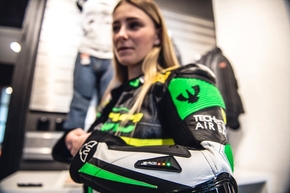Alexandra (Saša) Pelikánová experienced a formidable highside crash, within a group of other riders, during a SSP300 race at the Italian circuit of Misano. Just how did her protective suit, with its built-in air bag system, work? Did Saša escape without injury?
Saša Pelikánová’s fall at the Misano, SSP 300 race looked both dramatic and frightening. The highside accident launched Saša high into the air and unsparingly threw her back to the ground amongst a group of other riders.
What was going through Saša’s mind?
"I said to myself ... no, this can’t be happening to me, again .... even though it all happened very quickly, in my head it was as if time almost stopped, moving very slowly and I just prayed that none of the other riders would hit me."

Alexandra (Saša) Pelikánová, professional racer
How did it end up?
The end result was that Saša escaped without injury. Her PSí race suit and its integrated Tech-Air® system functioned perfectly together. We can take a closer look at the different phases of the fall and the workings of the airbag.
 Report from the software of the TECH-AIR® system
Report from the software of the TECH-AIR® system
Phase 1: Green Line - Normal riding
- software controlled airbag system constantly ‘monitors’ the users situation (riding, body movement, ..) thanks to the built in gyroscope and accelerometer technology in the back and shoulder protector areas. This leaves the rider unrestricted and untethered to the motorcycle in any way. The entire TECH-AIR® system is integrated with the race suit.
Phase 2: Yellow Line - Loss of control
- as soon as the system detects the hazard (evaluating successive accelerations within the individual X,Y and Z axis on each sensor) the airbag is deployed. On the track the user operates the system in ‘RACE’ mode which employs activation parameters based on collected data, representative of hazardous situations in the race environment. For normal road use ‘STREET’ mode is selected, where the software also monitors risk factors relevant to normal road traffic riding, such as impact when stationary from another vehicle.
Phase 3: Orange Line - Flight
- the rider and motorcycle have already parted company; it is during this time that the airbag is deployed. The system reacts so quickly that at the moment of impact with the ground the airbag is fully inflated and the body protected. In this instance the time between the airbag activation and contact with the ground was 285 ms, that means 240 ms before impact the bag was 100% full.
Note : The yellow vertical line on the graph indicates the start of airbag inflation, which typically takes 45 ms to complete (the blinking of an eye takes 100 – 400 ms).
Phase 4: Red Line - Crash
- rider hits the ground. By the time of contact the bag is "completely inflated = full reinforcement" in the neck, shoulder, clavicle, chest, back, kidney, abdomen and hip areas.
Phase 5: Light red Line - Sliding
- the rider is moving on the ground (sliding). Four seconds after activation the acceleration (loading) increases again which may be caused by the rider rolling or in the gravel trap and run off areas at the side of the track.
The time from detecting the hazardous situation, filling the airbag and impacting the ground is a matter of milliseconds. The entire event happens very quickly and after about five seconds from deployment the airbag slowly discharges.
What is done to the suit and airbag after a fall?
First it should be mentioned that in RACE mode it is possible to have two separate deployments of the system. This means that if the rider and motorcycle are all in order, it is possible to continue with protection available. The exception to this is if the suit is made in the largest size as both charges will be deployed at once to cater for the bigger user.

Ing.Libor Hubík, examines an airbag and suit at the PSi production facility
If both charge cartridges have been used and the LED indicator alerts to the need for service intervention, it is then required to send the suit and airbag vest to PSí. In our TECH-AIR® authorised repair centre a team member, directly trained by Alpinestars, will undertake a full professional inspection and repair. This work shall be done directly in our plant within ten working days.
Tip:
Did you know that the TECH-AIR® system has two modes? RACE (for the track) and STREET (for normal operation). Switchable depending on application. Interested? Read more about our airbag equipped suits.





